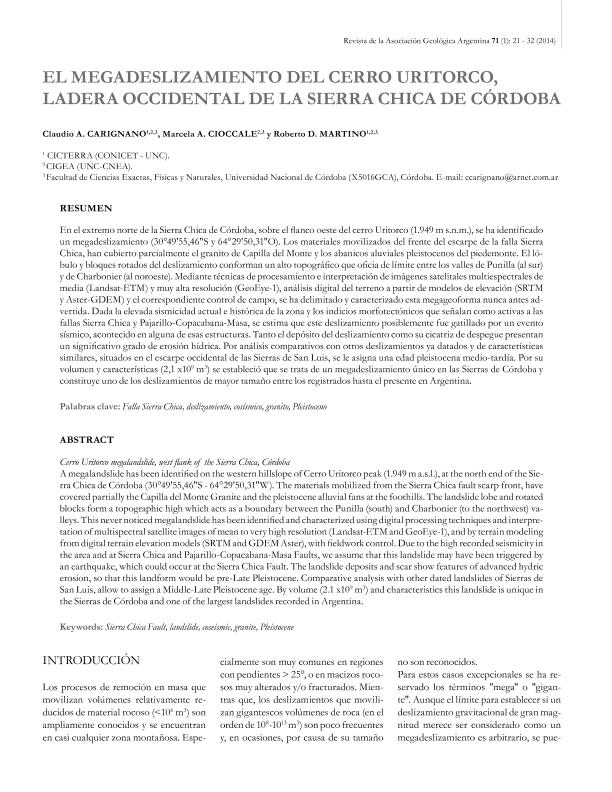Artículo
A megalandslide has been identified on the western hillslope of Cerro Uritorco peak (1.949 m a.s.l.), at the north end of the Sierra Chica de Córdoba (30°49´55.46"S - 64°29´50.31"W). The materials mobilized from the Sierra Chica fault scarp front, have covered partially the Capilla del Monte Granite and the pleistocene alluvial fans at the foothills. The landslide lobe and rotated blocks form a topographic high which acts as a boundary between the Punilla (south) and Charbonier (to the northwest) valleys. This never noticed megalandslide has been identified and characterized using digital processing techniques and interpretation of multispectral satellite images of mean to very high resolution (Landsat-ETM and GeoEye-1), and by terrain modeling from digital terrain elevation models (SRTM and GDEM Aster), with fieldwork control. Due to the high recorded seismicity in the area and at Sierra Chica and Pajarillo-Copacabana-Masa Faults, we assume that this landslide may have been triggered by an earthquake, which could occur at the Sierra Chica Fault. The landslide deposits and scar show features of advanced hydric erosion, so that this landform would be pre-Late Pleistocene. Comparative analysis with other dated landslides of Sierras de San Luis, allow to assign a Middle-Late Pleistocene age. By volume (2.1 m3x109) and characteristics this landslide is unique in the Sierras de Córdoba and one of the largest landslides recorded in Argentina. A megalandslide has been identified on the western hillslope of Cerro Uritorco peak (1.949 m a.s.l.), at the north end of the Sierra Chica de Córdoba (30°49'55,46"S - 64°29'50,31"W). The materials mobilized from the Sierra Chica fault scarp front, have covered partially the Capilla del Monte Granite and the pleistocene alluvial fans at the foothills. The landslide lobe and rotated blocks form a topographic high which acts as a boundary between the Punilla (south) and Charbonier (to the northwest) valleys. This never noticed megalandslide has been identified and characterized using digital processing techniques and interpretation of multispectral satellite images of mean to very high resolution (Landsat-ETM and GeoEye-1), and by terrain modeling from digital terrain elevation models (SRTM and GDEM Aster), with fieldwork control. Due to the high recorded seismicity in the area and at Sierra Chica and Pajarillo-Copacabana-Masa Faults, we assume that this landslide may have been triggered by an earthquake, which could occur at the Sierra Chica Fault. The landslide deposits and scar show features of advanced hydric erosion, so that this landform would be pre-Late Pleistocene. Comparative analysis with other dated landslides of Sierras de San Luis, allow to assign a Middle-Late Pleistocene age. By volume (2.1 x109 m3 ) and characteristics this landslide is unique in the Sierras de Córdoba and one of the largest landslides recorded in Argentina.
El megadeslizamiento del Cerro Uritorco, ladera occidental de la Sierra Chica de Córdoba
Título:
Cerro Uritorco megalandslide, west flank of the Sierra Chica, Córdoba
Fecha de publicación:
02/2014
Editorial:
Asociación Geológica Argentina
Revista:
Revista de la Asociación Geológica Argentina
ISSN:
0004-4822
Idioma:
Español
Tipo de recurso:
Artículo publicado
Clasificación temática:
Resumen
Palabras clave:
Sierra Chica Fault
,
Landslide, Coseismic,
,
Granite
,
Pleistocene
Archivos asociados
Licencia
Identificadores
Colecciones
Articulos(CICTERRA)
Articulos de CENTRO DE INVEST.EN CS.DE LA TIERRA
Articulos de CENTRO DE INVEST.EN CS.DE LA TIERRA
Citación
Martino, Roberto Donato; Cioccale, Marcela Alejandra; Carignano, Claudio Alejandro; El megadeslizamiento del Cerro Uritorco, ladera occidental de la Sierra Chica de Córdoba ; Asociación Geológica Argentina; Revista de la Asociación Geológica Argentina; 71; 1; 2-2014; 21-32
Compartir




